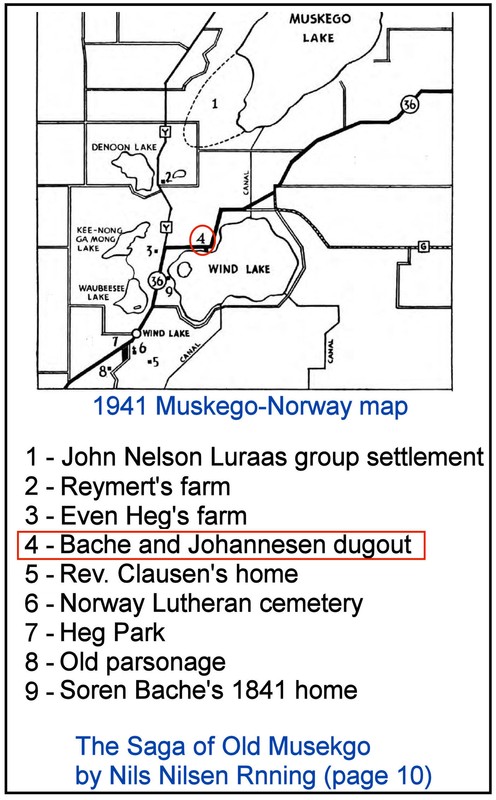Bache & Johannsen trading post
Introduction
Text-to-speech Audio
The rich Norwegian lumberman, Tollef Bache, was a Haugean who dreamed of starting a religious colony in America. He sent his son, Søren Bache and a trusted employee, Johannes Johannsen, to America with a strongbox stuffed with silver to buy land. The Haugen lay preacher Elling Ellingson was their traveling companion as they went to the Fox River settlement near Ottawa, Illinois to learn more about America from their fellow Norwegians.
In 1838, Bache and Johannsen wandered around northern Illinois and southern Wisconsin looking for available land. They settled on the isthmus between Wind Lake and Lake Waubeesa. Like many pioneer settlers, with the aid of newcomer Even Heg, they dug into the side of a hill and added a three-sided log structure to the front. Going to Milwaukee for supplies, Bache and Johannsen started a trading post, where settlers could barter butter, eggs and other farm crops for flour, coffee, sugar, fabric, buttons and other items which couldn’t be made at home. Like other pioneer convenience stores, it became the center of the community, where in winter or on rainy days, men would sit around a pot-bellied stove, smoke their pipes and tell tall tales.
Much of Tollef Bache’s money was used to make farm loans to other Norwegians in Muskego, Koshkonong and the Fox River settlement. Søren returned to Norway to get more funds. When he returned, while trying to collect money owed him, he accidently shot and killed the wife of a man who he had loaned money to. Not long after, his mentor Johan Johannsen, died at age 43. Søren was lost without Johannsen’s guidance. Søren’s father Tolef was on his deathbed, so Søren returned to Norway, never to return to America. James Denoon Reymert oversaw Bache’s remaining financial interests in Wisconsin.
Images
Bache & Johannsen dugout (trading post)

Backstory and Context
Text-to-speech Audio
Johannsen, Bache and the Haugean lay minister Elling Eielsen, emigrated as a trio. Tollef Bache paid for the trip of his advance scouts. They sailed from Drammen to Providence, Rhode Island, arriving in early September 1839. Johannsen safeguarded a strongbox holding Tollef’s money to be used for a new Haugean colony in America.
They visited Ole and Ansted Natesta at Jefferson Prairie, then headed back to the Fox River settlement for the winter.
The next spring, based on the Natestas’ advice, they went back to Wisconsin exploring for land to start a Haugean colony. Arriving at Muskego, Johannes decided not to settle with the Norwegians in the swampy bottoms bordering Big Muskego Lake. Instead, they bought land two miles south, including land purchased from an Irish squatter who had built a ramshackle hut on the scenic isthmus between Wind Lake and Waubeesee Lake.
To improve their living quarters, Johanssen and Bache, with Heg’s help, dug out a large Indian mound which stood as a grave site and memorial to the ancestors of pre-Columbian Native Americans. Johannsen and Heg may not have realized the spiritual significance of the mound until it was almost completely excavated.
Søren Bache wrote in his diary about their in-the-hill home:
We got a room twenty-four feet long, eighteen feet wide and seven feet high. The first story was entirely underground. Over it we built a loft five logs high which rested on six pillars about seven feet (tall). The walls of our dugout was so firm that there was no danger of a cave-in and we merely needed to provide it with wainscot in order to get a good warm dwelling.
The mound proved to be an Indian grave. At the bottom we found twelve or fourteen skulls and some other bones . . . They must have had a culture similar to that of pagan times in our own country, as is witnessed by the big (Viking) mounds in Norway, which can, in some ways be compared to this one.[1]
Their dugout trading post became the center of community life. As a pioneer convenience store and post office, one could get tobacco, coffee, flour, sugar or gunpowder on credit. Butter, eggs, chickens and pork were used as barter. It was a place where you could pull up a split log bench, sip whiskey, spit tobacco juice and swap stories about everyday pioneer life. Johannes was always ready to offer sage advice.
Cite This Entry
Palecek, Mike. "Bache & Johannsen trading post." Clio: Your Guide to History. August 11, 2024. Accessed April 21, 2025. https://theclio.com/entry/182960
Sources
[1] Bache, Soren. A Chronicle of Old Muskego : the Diary of Søren Bache, 1839-1847, C. A. Clausen, translator, page XXX
Rnning, Nils Nilsen. The Saga of Old Norway, page 10

